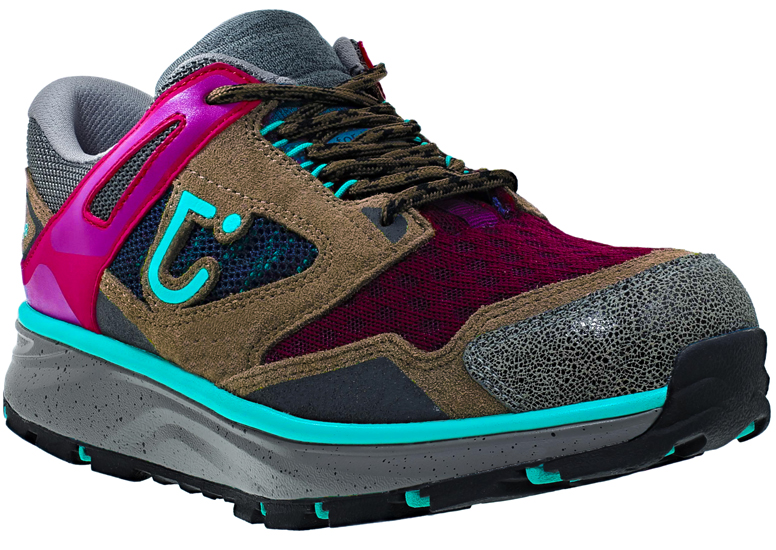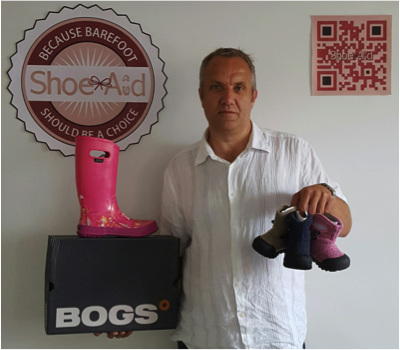 Joya: Frequently asked questions:
Joya: Frequently asked questions:
Before providing answers to your frequently asked questions, we would like to briefly explain one more time the effect that Joya has on the human body: Soft, supple surfaces take the stress off your locomotor system The positive effect of a soft, springy surface on the locomotor system (see also FAQs on “sensorimotor exercise”) has been put to good use by physiotherapists for a long time now and is a highly topical subject in the fields of prevention / rehabilitation.
The Joya brand has developed a shoe which makes use of this principle. The soft, supple material of the patented Joya sole means the load on the sole of your feet is ideally distributed as you walk and stand instead of being concentrated only on certain spots. When your heel strikes the soft Joya sole, your foot makes “micro-movements” which can also activate the muscles around the joints in the feet, hips and back. The soft polyurethane soles provide effective cushioning, which can take the pressure off your backbone and lighten the load on your spinal discs. General Does Joya support sensorimotor exercise?
The word “sensorimotor” is made up of two parts and can be roughly defined as ideal interplay between sensory processes (in the nerves) and motor processes (in the muscles). One key element of sensorimotor exercise is that it is carried out on a soft, moving surface. Sensorimotor exercise in Joya shoes activates the small muscles around the joints more strongly, which can help take the load off your joints and spinal discs. Renowned doctors, orthopaedists and gait specialists recommend Joya.
I suffer from diabetes. Can I wear Joya shoes
Joya shoes can be worn by patients with either insulin-dependent (Type 1) or non-insulin-dependent (Type 2) diabetes. Wearing Joya shoes stimulates the blood flow in the legs and is also a good means of improving your sensorimotor system. That is a preventive advantage for people who develop neurovascular complications.
Why do Joya shoes have different soles?
Years of experience and constant communication with our customers tells us that people have very many different needs and expectations when it comes to their shoes. For some customers a roll-through shoe is the best concept for their comfort and wellbeing, while others want comfort and wellbeing combined with fashion, and others need shoes to solve problems with their locomotor system. All Joya soles have one thing in common: they turn the hard, flat ground into a soft, supple surface, giving wearers comfort, wellbeing and a very special feeling when walking.
Can children wear Joya shoes?
The Joya size range is made to suit its intended target group (EU sizes 35–49 / UK sizes 2–14). Any age group can benefit from Joya technology.
What is the difference with MBT shoes?
MBT was launched on the market as a medical exercise device. Joya is a comfort shoe whose soft sole from heel to toe additionally offers health benefits. In the case of Joya, the super-soft polyurethane material stretches over the whole sole, while in MBT shoes it is only found around the heel. This means that Joya shoes envelop your feet extremely softly. In MBT shoes there is a hard plate which provides the “rocker effect” when you stand and guides your feet as you roll through a step. At Joya we embrace the philosophy of allowing natural freedom of movement, keeping your feet in charge, meaning that the small muscles in the feet can be targeted more precisely and allowing a more natural roll-through movement than in MBT shoes. Moreover, with Joya shoes you do not need any special gait training as with MBT.
What is the difference with the KyBoot?
Basically the two products shared a creative cradle: the functional shoe company run by the Müller family of Roggwil, Switzerland. Both sole concepts are based on soft polyurethane material and the positive effect which a soft, supple surface has on the body. Unlike KyBoot, Joya shoes have different soles for different target groups and also focus especially on meeting customers’ wishes regarding fashion. In the case of KyBoot shoes the priority is on medicinal exercise. In other words, Joya shoes can be described as everyday comfort shoes which are also good for you, while KyBoot shoes are medicinal exercise devices.
Why has little research been carried out on Joya?
The aim of the study on Joya shoes carried out by the Swiss Federal Institute of Technology (find out more at studies) was to evaluate whether they had a positive mechanical influence on the human gait, and this was indeed proven in the study. Joya shoes were basically developed as comfort shoes, and it was only thanks to endless positive feedback from customers and recommendations by doctors for patients with locomotor system problems that the “health shoe” image came about.
Prof. Dr. med. In a report on Bavarian radio on 27 January 2014, Hans Henning Wetz, director of the clinical testing centre for orthopaedic aids at Münster University chair of orthopaedic technology explained: “That’s the way it is in medicine; it’s the way in orthopaedics, and it’s the way with orthopaedic aids. We face the same problem with many other devices we have: we know they work, but we don’t know why.” In summary it can be said that though the analytical approach used in clinical studies is a legitimate, serious method, orthodox medicine and physiotherapy are generally based on empirical science.
As a golden principle, the wellbeing of the patient / customer must come first. The effect that a soft, supple surface has in terms of sensorimotor exercise is currently a hotly discussed topic in orthodox medicine and physiotherapy, and it is precisely the approach that Joya has introduced to people’s everyday lives in the form of a soft, supple sole
Foot problems
Can Joya help with general foot pain?
Thanks to their soft soles, Joya shoes lighten the load on your heel, forefoot and midfoot, which can be helpful with various kinds of foot pain.
Can I wear Joya shoes if I have fallen arches / flat feet?
Joya stimulates the muscles in your foot. Joya helps you to roll your foot through on the outer side and can thus help take the load off the overtaxed structure on the inward side of flat feet.
Can I wear Joya shoes if I have very high arches?
The soft sole adapts to fit the shape of your foot well. If you have extremely high arches, however, it is indeed advisable to use a soft additional insole.
Do Joya shoes help with plantar fasciitis / heel spurs?
Joya can help with plantar fasciitis, as the soft sole reduces the pressure on the curve in the foot where the plantar fascia is located. If the inflammation has already ossified (as a heel spur), Joya shoes’ soft sole can have a positive effect on pressure, taking the load off the ailing structure.
Can I wear Joya shoes with orthopaedic insoles?
Orthopaedic insoles can be worn in Joya shoes, though we do recommend wearing insoles that are as soft as possible or designed for sensorimotor exercise, to ensure that the Joya shoes can maintain their function. We also recommend wearing your Joya shoes without insoles at certain times to give your muscles the exercise they need.
I suffer from bunions / arthrosis of the main joint of the big toe. Can Joya help me?
Joya changes the load distribution over the sole of the foot, ensuring that the load is evenly distributed from the moment the heel strikes the ground to the point when the foot lifts off from the ground from the tips of the toes. With conventional shoes, most of the pressure is on the heel and forefoot, coming to a peak in the big toe at heel-off. This can lead people to suffer potentially painful problems such as bunions (Hallux valgus) or, later, arthrosis of the main joint of the big toe (Hallux rigidus).
I have metatarsalgia, can Joya help me?
Joya can help with metatarsalgia, as the soft sole lightens the load in the forefoot. Some Joya soles feature an additional, ultra-soft forefoot cushion to reduce the load in the case of pain of this kind.
Would you recommend Joya shoes for Achilles tendon problems? What should I look out for?
In the case of tendon overuse injuries, a common occurrence when the Achilles tendon is overtaxed, relief mainly comes from stretching, putting weight on the tendon in a physiologically appropriate manner (pressing down hard on the outer heel without bending inwards) and keeping the blood flowing through the area. With their soft sole, Joya shoes perfectly cushion impacts on your joints and feet; they are recommended by doctors and physiotherapists to patients recovering from pain in the Achilles tendon. Your feet may well need a certain amount of time to get used to the shoes. Feedback from our many satisfied customers with a history of Achilles tendon problems shows that the shoes have been a great help. If in doubt, discuss the procedure with your doctor or orthopaedic specialist.
Knees and hips
I am about to get an artificial knee / hip: can I wear Joya shoes?
Walking on a soft surface in Joya shoes forces your body to make tiny balancing movements, which means more work for the joint-stabilising muscles in your hips. The soft Joya sole also cushions the impact on the hard, flat ground. All these factors can be of advantage, especially at the pre-operative stage.
I have an artificial knee / hip. How long after the operation can I start wearing Joya shoes?
We recommend waiting 6–8 weeks after the operation before wearing Joya shoes, though they can be worn in the post-operative phase under the supervision of your doctor or therapist.
I have legs of different lengths and have to wear insoles. Can I wear them in my Joya shoes?
Heel lifts can be worn with Joya shoes when there is an actual difference in length of more than one centimetre (due to a congenital abnormality or a fracture of the thighbone or shinbone). If the difference is less than one centimetre it is not normally necessary to wear heel lifts.
Back pain
Is Joya suitable for back problems?
At foot strike, your foot sinks into the soft Joya sole, causing the pelvis to be lowered on that side. This movement in turn means that the back muscles need to work more, which can have a positive effect on back problems. The soft Joya sole also cushions the impact on the hard, flat ground, which can also be beneficial in the case of back problems.
I have / had a slipped disc; should I wear Joya shoes?
In the case of acute slipped discs or shortly after an operation on your intervertebral discs, we only recommend Joya under the supervision of a doctor, as the additional movement in the pelvis can be counter-productive in such cases. Once the problem has been dealt with, Joya shoes can be worn both during the post-operational stage and as a means of prevention.
Contact: Joya UK | Golden Concept Ltd | PO Box 1368 | Barking | IG11 1HF
Tel. +44 7809 207473 | info@joyashoes.co.uk | www.joyashoes.co.uk




